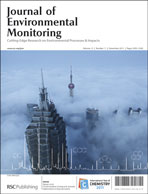This study aimed to assess soil quality by chemical and ecotoxicological investigations and to check the correspondence between soil metal concentrations and ecotoxicity. For these purposes, surface soils collected at four adjacent roadside urban parks and at a former industrial area were characterized for C/N, organic matter content, texture, and pH. Cr, Cu, Ni and Pb, chosen among the most representative soil metal contaminants, were measured as total content and as available and water soluble fractions. In addition, the total concentrations of the investigated metals were used to calculate two chemical indices: the contamination and the potential ecological risk factors. The toxicity of the investigated soils was evaluated by an ecotoxicity test battery carried out on both soil samples (Vibrio fischeri, Heterocypris incongruens and Sinapis alba) and elutriates (Vibrio fischeri, Daphnia magna and Selenastrum capricornutum). The findings, both by the chemical and ecotoxicological approaches, would suggest that the soils with high metal contamination pose ecological risks. On the other hand, moderately metal contaminated soils did not exclude soil ecotoxicity. In fact, toxic effects were also highlighted in soils with low metal content, toxicity being affected by metal availability and soil characteristics. Moreover, the results suggest the importance of using a battery of tests to assess soil ecotoxicity.


 Please wait while we load your content...
Please wait while we load your content...